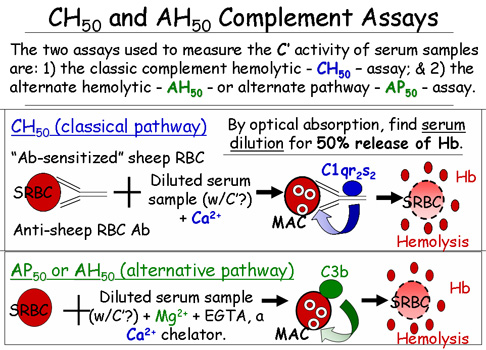Complement (C') Assays
A collection of nearly two
dozen enzyme precursors, regulatory proteins, and membrane receptors together define the C' system and its activities. C' components are found in high concentrations in the blood, and they can be found in other normal or diseased anatomical niches. When appropriately activated, this system generates numerous protective molecules that facilitate immune responses against pathogens, particularly bacteria. One critical outcome of C' activation is the insertion of C' components into the plasma membranes of targeted cells thereby creating permeable pores that result in rapid cell lysis and death. Thus, if the C' system is defective for one reason or another, an individual may have impaired immune responses against certain types of pathogens. However, the C' system can also become misdirected and inappropriately attack and kill host tissues and cells. Thus, a variety of techniques have been developed to evaluate this system in a clinical setting. Standard biochemical and immunological techniques can be used to determine the complement proteins levels in patient samples. These methods may uncover the absence, abnormal structure, or abnormal behavior of a C' component. However, some individuals with C' deficiencies produce nonfunctional C' proteins that are not distinguishable by these methods. Thus, it is necessary to test for C' component function and this is usually accomplished by testing patient samples in hemolytic asssays that are designed to evaluate the potency of two major pathways of C' activation, the so-called classical and alternate pathways. These pathways are initiated by a different set of factors and conditions, as illustrated in the upper figure below, but the assays typically used the capacity of activated C' to lyse foreign RBCs in vitro (see the right figure below).
Classical and Alternate Pathways of C' activation
- The classical pathway of C' activation is normally triggered by antibody-antigen complexes. Thus, the ability of human serum to activate the classical pathway in vitro (see top half of the figure on the right) can be evaluated by adding serially diluted serum samples to antibody-coated foreign RBCs (usually sheep or rabbit RBC). The degree of RBC hemolysis resulting from activation of this pathway depends on the concentrations and integrity of several C' components including C1 through C9 (See C' System Overview).
- The alternate pathway of C' activation is normally triggered by pathogen-associated molecules in vivo. However, when human serum samples are mixed with foreign RBCs, some C3b is spontaneously generated (by C3 auto-proteolysis or other mechanisms) and RBC hemolysis ensues (See bottom half of the figure on the right). The hemolytic activity resulting from activation of this pathway depends on the concentrations and integrity of several C' components including Factor B (FB), Factor D (FD), and Properdin (P) as well as C3 through C9 (See C' System Overview).

Quantitative measurement of the C' activity
The level of C' activity in a given sample is traditionally measured in terms of two hemolytic assay parameters - CH50 or AH50 - which correspond to the concentrations of serum that yield 50% lysis of RBCs under appropriate conditions (as summarized in the figure on the left). A hypothetical determination for CH50 is illustrated in the image below.


